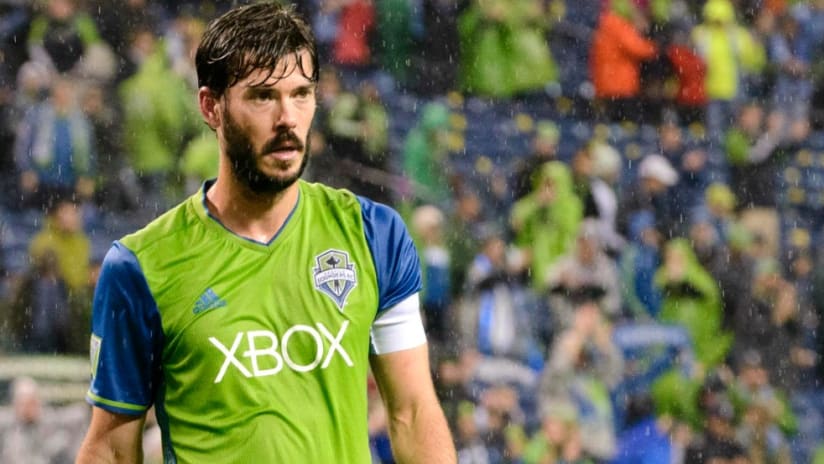Sean Franklin. Brad Evans. Alan Gordon.
All longtime MLS veterans, all contributors when healthy in 2017, all MLS free agents. All unsigned.
They’re emblematic of a free agent crop that’s having a bit of a rough go this winter. The market is moving at the slowest pace since MLS introduced its version of free agency ahead of the 2016 season, with signings few and far between and plenty of players unsure if they’ll be on an opening day roster.
Only six free agents – Steven Beitashour, Ricardo Clark, Jordan Harvey, Chris Pontius, Chris Seitz and Sal Zizzo – have switched MLS clubs this winter. Another eight have re-signed with their previous teams, while one moved abroad and another retired. In total, only 15 players out of an initial list of 38 free agents have signed new contracts this offseason, while only 16 are in settled situations.
That’s behind the pace we saw in the first two years of MLS free agency. At this point in the 2017 preseason, 17 out of 37 eligible free agents were under contract and another 11 had retired. Even more players were signed at this point in 2016, when 19 out of 29 free agents were under contract and two more had retired.
A variety of factors – overall quality of the free agent pool, team needs, what salary a free agent is willing to take and the fact that teams don’t feel like players like Franklin, Evans or Gordon need an extended preseason – are contributing to the slowdown, but the addition of discretionary Targeted Allocation Money in December has been the most significant drag on the 2018 MLS free agent market.
The league announced just before MLS Cup that each team would be able to spend up to $2.8 million in discretionary TAM in 2018 and 2019. That’s already changed the way clubs are building their rosters, opening new markets for teams to recruit from and expanding those that they already look at.
“I do think that the availability of more money broadens the pool of players that you think are available to you, whether that’s real or imagined,” Chicago Fire president and GM Nelson Rodriguez told MLSsoccer.com. “I do think that that has impacted our decision making, that has impacted how we have viewed this free agent class vis-à-vis what may be available across all available options.”
Because the new money came into play relatively late in the process, teams – who often try to plan their transfer windows months in advance – have been playing a bit of catch up this winter. Most still have plenty of discretionary TAM to play with, and many are still actively searching for players to spend it on. Until they get those players under contract, they don’t know exactly what their needs are. Until they know what their needs are, they don’t want to spend significantly on free agents, many of whom are older and unlikely to play huge roles in 2018.
“It’s given us more time to consider more options,” Rodriguez said. “Is there a better alternative that’s coming from outside the league, whether that’s from a lower division team within the US or Canada or from outside MLS and outside the US and Canada altogether? For us, that’s how we’ve viewed it. … It’s comparing [a free agent’s] services to what we project might be the ultimate gain from someone different.”
This is about more than timing and team needs, though. The very structure of TAM is slowing the free agent market. With TAM, teams can acquire a player from abroad, sign him to a contract above the maximum budget charge (expected to be $504,375) and then buy his cap hit as low as $150,000. More TAM means teams can do that more often. Correspondingly, free agents that cost anywhere near $150,000 – a number that many of them made in 2017 – have become less and less attractive.
That’s not to say there’s no value in free agents. Even players like Evans or Gordon who haven’t been full-time starters for a few years are quality depth, strong in the locker room, MLS savvy and American. There’s a market for that type of player, especially considering each MLS team has a limited number of international spots.
But that market isn’t what it used to be. Rodriguez didn’t comment on any specific offers, but conversations with more than 10 other coaches, club executives and agents have led to a broad consensus: This winter’s free agent offers have been lower than in previous years. Many have pointed to the additional infusion of TAM as one reason for the down market. If free agents want to end up on rosters, several have said, they’ll have to take smaller deals.
As the season approaches, it looks like a few of those players are getting that message. Evans joined Kansas City’s camp Monday; Gordon has reportedly drawn interest from Chicago; Franklin is training with Vancouver. If they so desire, that trio will more than likely be on an MLS roster come March 3, as will several more of their free agent friends. The process just hasn’t been as smooth as they probably hoped.










